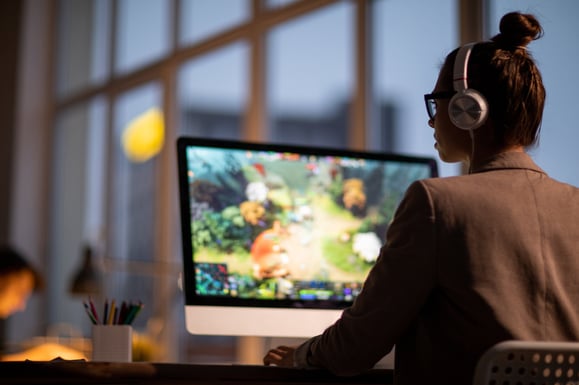These days, videos are everywhere. Social media, mobile apps, streaming platforms, blogs—wherever there’s a screen, videos are sure to follow. They're also becoming central to many educational tools, particularly now as more learning goes digital. As a result, online education providers may be finding themselves suddenly grappling with questions about copyright. If you’re in this boat, you might be asking yourself questions like:
- What is copyright?
- How does it apply to videos?
- Can I just use what I find on the internet in my product?
- How do I obtain the rights to use videos?
These aren’t easy questions to answer—especially not in a single blog post. Copyright law is complicated stuff, but we’ll help break down some of the most common questions and misconceptions.
Let’s start with the most basic, but legally also the hardest, question:
What is copyright?
Copyright is a type of intellectual property right that protects original works of authorship. Such works include:
- Literary works (e.g., computer software, books, essays)
- Dramatic works (e.g., plays, musicals)
- Musical works (e.g., songs, sounds, spoken word)
- Artistic works (e.g., paintings, drawings, photographs)
Copyright is a legal protection provided to the creator(s) and owner(s) of the original work of authorship, and is granted from the time the work is created, regardless of whether it is published or not.
Let’s take a non-video example. Say Joe is an avid photographer, and birds are his favorite subject. He hasn’t formally published any of his images, but he sent a few of his favorites to fellow bird enthusiasts. One day Joe is thumbing through a coffee book of exotic birds and is shocked to see one of his photographs staring back at him! Because the government extends copyright even to unpublished works and grants ownership to the original author, Joe has a legal recourse to pursue damages on the grounds of copyright infringement.

What are some exceptions?
Not everything is protected by copyright. Works that exist in the public domain (i.e., not protected by copyright law) include:
- Titles, names, familiar symbols
- Ideas, methods, concepts, principles
- Works consisting of entirely self-evident facts (maps, calendars, etc.)
- Works whose copyright has expired
How does copyright apply to video?
Videos are complex. Unlike still images, videos are made from many different parts that can influence the rights associated with the use of those videos.
For example, let’s say Jill creates a 5-minute video about exotic birds for the educational company she works for, EduFly. About a minute into the video, Joe appears on camera for just a few seconds to talk about the Atlantic Puffin. Joe signed a personal release, giving Jill permission to use his image in the video for EduFly’s purposes only. This means that although EduFly can use the video in their website and place it on their Youtube page, if YOU wanted to use that video in your educational product, EduFly would either need to edit it to remove Joe’s image or reach back out to Joe to obtain his permission. Now what if Jill’s bird video doesn’t just include one individual, but dozens, each of whom need to be contacted? That’s a lot of permissions to manage.
But the complexity doesn’t stop there. Each location, each piece of music used in the score, each piece of personal property, artifact, and trademark is also protected by copyright, so before you could use the video, each work within that single video would need to be cleared.
Can I just use what I find on the internet in my product?
That’s a big NO. Although you may easily view a video on YouTube, this does not mean that the content is readily available for YOUR use within YOUR educational product.
A couple of common misconceptions about using content found on the internet are:
- If content can be found on one medium, it is clear to use by all others.
- If the public has already seen the material on YouTube or another site, it is publicly accessible and therefore in the public domain.
Both of these assumptions are FALSE. Even if you see a video on a website, that still doesn't mean that the copyright owner of this material has the legal right to allow you to add it to another platform and commercialize it.
Just because content has been viewed a million times, it’s not “out there” and “available” for you to use. That is not the definition of public domain. It doesn't matter how popular that content is or how many times it's been viewed online; it also doesn’t matter if you found it on seemingly “public” online places like Facebook, or YouTube, or your friend’s blog. Content only becomes public domain if the copyright has expired (typically the life of the author plus 70 years after their death, although this varies by country).
Before assuming a piece of content falls in the public domain, you need to do your research, which requires locating the original source of the content, which can take some digging. Sorry, but a YouTuber’s claim that their post falls into the public domain doesn’t count as valid research of source. Even well-intentioned YouTubers sometimes mistakenly post material that they should not, and the remedy to the content owner if they ever find the material is a take-down. (Should that video be in your online course, your learners now see an error message where an educational video used to be. Not a great user experience!)

How do I obtain the rights to use a video?
Before you use any content in your educational product, you need to make sure you can legally use that content. This is called rights clearance.
Like copyright itself, rights clearance is complicated. Established academic publishers have entire departments (typically Rights and Permissions) whose job is to ensure all appropriate licenses and permissions are in place before third-party content is used in their products, whether that content is images, text, music, or videos. While these positions may not exist in smaller publishers and education companies, those companies are no less liable should they inadvertently infringe upon a copyright owner’s protection. They must be just as rigorous in their efforts to minimize risk, even if they have less resources to do it.
Rights clearance involves too many nuances to be covered here, but generally speaking, those steps involve:
- Identifying the protectable content. In the case of videos, you’ll need to consider both the work in its entirety as well as each copyrightable element (music, images, etc.)
- Determining who owns the rights. This is sometimes straightforward, but because rights are transferable, it’s often not as obvious as it may appear. Just because a video appears on a content provider’s web page, does not mean it was produced by that content provider. They may have licensed that video from the original creator, who remains the copyright holder. You’ll need to do your research, and if you still can’t find the right’s holder, you might need to engage a professional search firm who can help you find the source.
- Evaluate whether to seek permission. There are some circumstances where it’s not necessary to seek permission from the rightsholder, such as when a video falls into the public domain (copyright has expired) or is covered by fair use (this is complicated, but essentially involves material that may be used for a limited and transformative purpose - e.g., a parody). For everything else, you’ll need to get the copyright(s) cleared before you can add the video to your product.
- Seek permission. Approach the rights holders you’ve identified in step 2. Email is generally the best approach, as it allows you to keep a written record of the permissions you receive. Be sure each of the following terms is addressed in your correspondence:
- Term - The total length of time you are allowed to use the video
- Territory - Geographic region you can use each clip
- Scope of use - How much of the content you are using and for what purpose
- Payment - How much you are expected to pay the copyright holder
- Media - How are you using the content and how will the end client access the content? Will it be downloadable? Streamed subscription video on demand (SVOD)? Free video on demand (FVOD)? Advertising-based video on demand (AVOD)?
- Keep track of your permissions. You’ll need to develop a system to help you track permissions and ensure the videos you’ve used in your courses do not exceed the terms you establish in step 4. If you secure a 3-year term on a video, you’ll either need to go back to the copyright holder to extend the terms leading up to the 3-year mark or remove the video before the term expires to avoid copyright infringement. Because of the complexity involved, you may need to invest in a media asset system or contract management system to help you keep tabs on the permissions you have in place.
This seems like a LOT. How can I simplify and save time??
Copyright clearance isn’t for the faint of heart. Some education providers avoid using video in their digital courses precisely because the process is so burdensome. It’s easier not to use videos at all than to track down permissions from each individual rights holder or risk potential infringement (even inadvertent!). But in a world where both students and teachers expect video in their online learning, ignoring video ultimately only hurts your product.
You could create your own videos as an alternative, but that’s an expensive, resource-heavy proposition that comes with its own set of headaches. Plus, it won’t get you off the hook for rights clearance, sadly. That music you want to use? You’ll need permissions for that. That image you want to use? More permissions. Those individuals on camera? Yep, you’ll need permissions from them, too. You could just ensure that every element within your video is previously rights-cleared, but you’ll need to keep tabs on those assets. This requires developing or using a system that can alert you to expirations lest you have to take down your video or (worse) pay damages.

The easiest way to include high quality, engaging educational videos in your courses is to have a third party do the heavy lifting for you. That’s where Boclips comes in. We’ve already established relationships with over 200 top video brands (the likes of AP, PBS NewsHour, MinuteEarth, LearnZillion, etc.), clearing the rights to over 2 million educational clips to make them available to you under one simple, single educational license. With our standard license, you can use any video clips from the Boclips library in your educational platform (be it web-based, app-based, or an offline product) for a 5-year term with worldwide distribution. Depending on the original content provider, our agreements allow you to edit downloaded videos to suit your specific learning objectives and use assets to promote your products or services.
A recent Kaltura report showed that 82% of teachers see students demand for video in education as increasing (Kaltura, 2019). So, whether you decide to tackle rights clearance yourself or choose to bypass the hassle altogether by getting a single license through Boclips, don’t let copyright get in the way of your video ambitions. Just make sure you’re covered!
Want to learn more about how we can help you get up to speed? Schedule a free consultation to talk to us about your video needs.
- #Classroom
- #Video in Digital Learning
- #Educational Videos
- #Tips for Using Video
- #Video Content Partners
- #Boclips for Publishers
- #Issues in Education
- #Educational Videos by Subject Area
- #News and Announcements
- #Events & Holidays
- #Video and Teaching Tools
- #Teaching Methodologies
- #Education Videos
- #Video and Digital Literacy
- #Short Educational Videos
- #Instructional Design
- #Multimodal Learning
- #Video and Student Safety
- #Accessibility in Education
-3.png?width=390&height=223&name=Untitled%20design%20(2)-3.png)


.png?width=1152&height=660&name=Copy%20of%20Untitled%20Design%20(1).png)
.png?width=352&name=Blog%20banner-%20Top%20Ways%20Videos%20Can%20Be%20Used%20in%20Higher%20Education%20(2).png)



